Wild guppy3 (endler's guppy)
Endler

One type of wildguppy is the wellknown endler. Also known as Poecilia wingei or "Endler's livebearer". I deliberately split up a the section of endlers and wild guppies because in the aquarium scene, endlers is being seen an own species while in fact they're also a wild guppie
When I consider my own country, I can be considered being one of the pioneers of endler keeping. This was way before commercial interest in endlers came globally into play.
.
They're found in streams, ponds and lagoons in both Campoma and Cumana region in Venezuela. Endlers were originally discovered in the late 1930's, by Franklyn F. Bond, only to be forgotten for about another 40 years until being rediscovered and published by Dr. John Endler in 1975 and whom they were named after.
Dr. Klaus Kallman (genecitist) from the New York Aquarium determined this livebearer as a specific species within the Poecilia genus. It was he who named this species Endler's livebearer and the scientific name Poecilia endler. Dr. Endler himself found out that this little livebearer was named after him when he was sitting in the audience at a meeting in Germany in 1980. Dr. Kallman didn't notify him before about the chosen name.
In 2005 Fred Poeser, Michael Kempkes and Isaac Isbrücker published a paper about this specific livebearer and renamed the scientific name into Poecilia Wingei named after Danish biologist professor Øjvind Winge (active as geneticist and mycologist).

Above: Fred Poeser and me.
Dr. Fred Poeser (PhD., Ichthyology) and Michael Kempkes are friends of mine.
Below: Michael Kempkes (left) and me (front). We were in a goofy mood...


Left: Fred N. Poeser
Right: Michael Kempkes

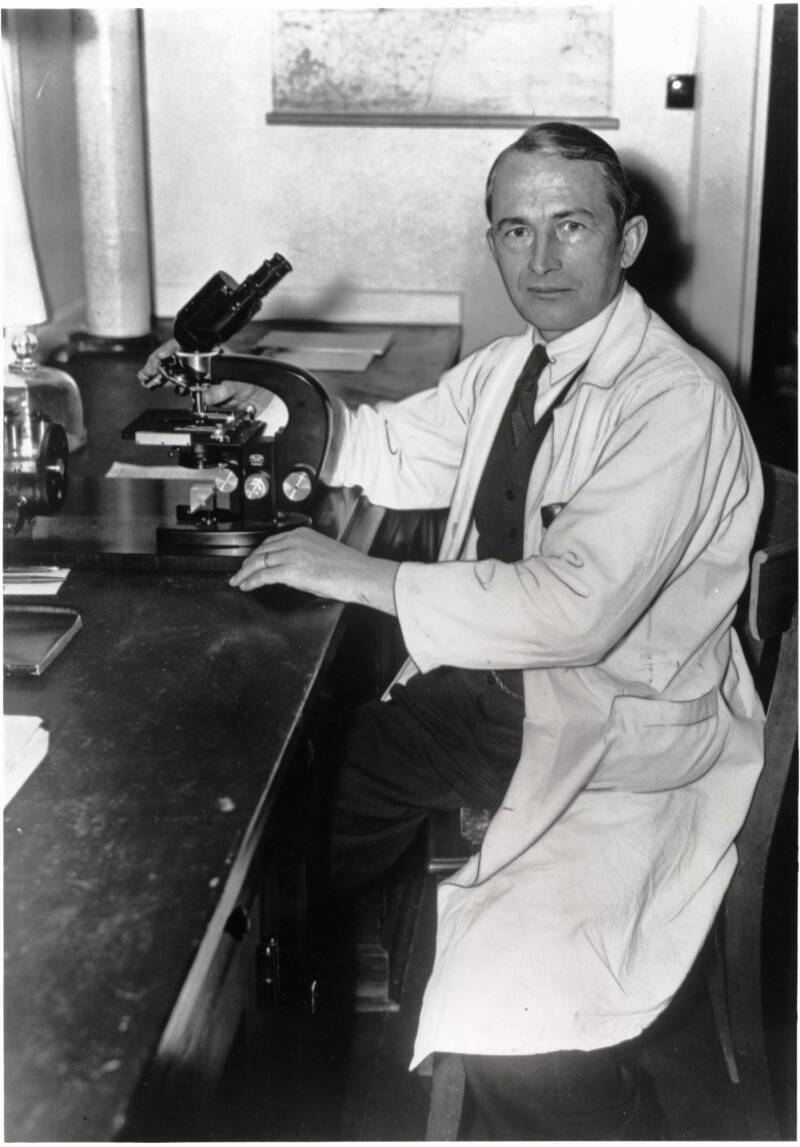
Øjvind Winge (☼ May 19, 1886 – † April 5, 1964) was a Danish biologist and pioneer in yeast genetics.
Are endlers the same as wild guppies?
To answer this question, I'd like to state that pure endlers (Poecilia wingei) are guppies. But not all wild guppies are endlers. The difference is in their DNA. Just like the other wild guppy species like Poecilia obscura and Poecilia kempkesi. This is also why we call pure Poecilia wingei "endler guppies".
Are all wild populations of endlers different strains or are they just one and the same...?
I myself would prefer to label them as endler varieties instead of strains.
For what's not really clear, is that those varieties in the wild could be diffferent strains but they could also be the same strain (for Poecilia wingei is an own species) but different in phenotype caused by environmental influences. Which is something that does happen in populations of several other livebearers as well. In last case, many wild varieties look quite differentl from another and a certain number have just minor differences. So, there's still something to explore...
Certain descendants of these fish collected by Dr. John Endler in 1975 remain due to hybridization and inbreeding. In the 1990's Dr. John Endler urged Amando Pou to gather fresh wild endler stock. Pou collected lots of wild endlers and provided them to Adrian Hernandez. Adrian Hernandez reboosted the introduction of the endler into the freshwater aquarium scene. In following years Pou collected more strains of wild endlers in Venezuela for Hernandez.
Adrian's Endlers Livebearer Association of America (ELAA) stock is now considered the ELAA original source for Pure-Strain Endlers. In order for an ELB to be considered an N-Class Pure-Strain fish, its lineage must be traced back to this original stock and verified by documentation throughout the entire line of descent.
Class → refers to a fish's documented lineage how pure-bred/hybridized it is.
Strains → refers to groupings of characteristics which breed true generation after generation.
Grade → refers to standards individual fish can be judged against as they relate to a "prime" or "perfect" within a given strain.
There are three classes of endlers and numerous strains.
Class-N → Are documented to have originated from their native waters in Venezuela and are considered genetically "pure". This also includes progeny from these endlers.
Class-P → Appear to have the characteristics of an endler (Class-N), but whose origins can't be verified. Strains are similar to Class-N.
Class-K → Are known to have been crossbred with other livebearing species.
********************************************************************************

Above: Adrian Hernandez

As far as known there are several strains which occur actually in wild nature with a broad spectrum of colours and different shapes (body, fins and tail)
Just like wild guppies, the males are smaller in size than the average domesticated male fancy guppy. However, the male endler seems in general to appear more intense colored than most male wild guppies.
I would like to mention that either way endler females have the potential to reach a normal length of a female fancy guppy. But most of the time the females are already impregnate before they've reached that size. And therefore it appears in general as if also endler females are smaller than the fancy guppy females. For all grow potential will go to the development of the new offspring instead of its own body.

Above: This is how an average female endler looks like.
On this page I'll describe just the males of each endler breed I'm keeping. For no matter which kind of endler I'll consider, the females will be basically similarly colored from grey, tan, greenish till dark brown. Some females tend to have some markings in their fins or even on their sides. But if you'd like to breed with endlers it does matter which female of which strain you use to ensure the right characteristics in the offspring. For I have heard of certain breeders that all female endlers have recessive genes "at all times". This is something I absolutely disagree with looking back to my former breeding projects. In my point of view depending on the strain they can be homozygote or heterozygote.
Endlers in general ain't that demanding and are quite hardy when it comes to water conditions. Which makes it in general also an easy fish to keep. I explicitly mention "in general" for there are also strains which have a difficulty level.
Although, I'd prefer watching them swim in a large tank, it's really a fish one could keep in a small tank as well. Nano-aquariums are a typical trend these days and they'll do well once placed in such a tank. And I do have to admit that such a small biotope does really have its own charm as well...

Above:
A sample of a wild Poecilia reticulata (top) and a pure Poecilia wingei (bottom) where the iridescence between both species is very clear.
Photo courtesy by Adrian Hernandez.
How to label a hybrid endler strain?
In the commercial trade, the scientific name "Poecilia wingei" is often given to the socalled endler hybrid strains. This would be an incorrect statement. For the scientific name "Poecilia wingei" can only be given to pure endler strains. And not to hybrids. So, how do we have to call them then? Best way is to label them as being an "endler hybrid" or "endler hybrid strain" in case of a strain. Would one give a scientific name to such an endler hybrid (which isn't common), "Poecilia endler sp." or "Poecilia wingei cf." would be the best fit scientific notation. But again, it's not common to give hybrids a scientific name.
I won't describe N-, P- or even K-class separate from eachother. They'll be described overhere (with the exception of my own created strains) on this page in random order. But I'll state whether it concerns a pure endler or an endler hybrid strain.
Black bar
The black bar endler is the most common endler there is and originated from the Cumana region (Laguna De Los Patos).
In commercial trade N-, K- and P-class are available. Most of the sold fish will be K- and P-class. It's a shame that I see a lot of people (especially within the commercial trade) sell K- and P-class as being N-class. Despite of the fact that this is the most common endler there is, I still have a preference to keep these guys at home. Besides that they're vividly colored, they're also of good use regarding my hybridizing projects.
I myself started keeping black bars ever since 2004.
A quite lively colored fish of a small size. I've used black bar endlers as well to interbreed with other wild guppies and other endlers to get a certain strain. At some point the black bar has even disappeared in the male pattern when they were crossbred with red chest endlers. In that case the monocle on both sides of the male seemed dominant to the black bar.
But in general when a black bar endler is crossbred with a different endler strain or guppy strain, the black bar marking on the male's chest will inherit dominant. And within the commercial trade you'll see a lot of male fancy guppies have that specific marking. Pretty sure, some black bar endler influence is running through their DNA.
Below: Two male specimens, Picture 1 (K-class), Picture 2 (N-class).
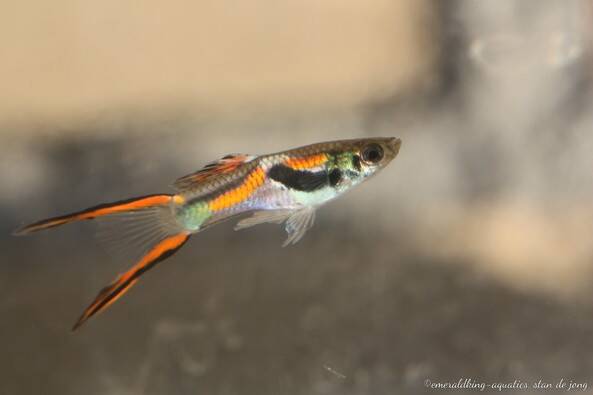

The name "Black bar" doesn't need too much explanation. It's obvious that the black bar on both sides does the job.
There can be differences between the markings of each individual male. But the coloration is very characteristic. Red (or orange), green and black markings are very typical to the black bar endler.
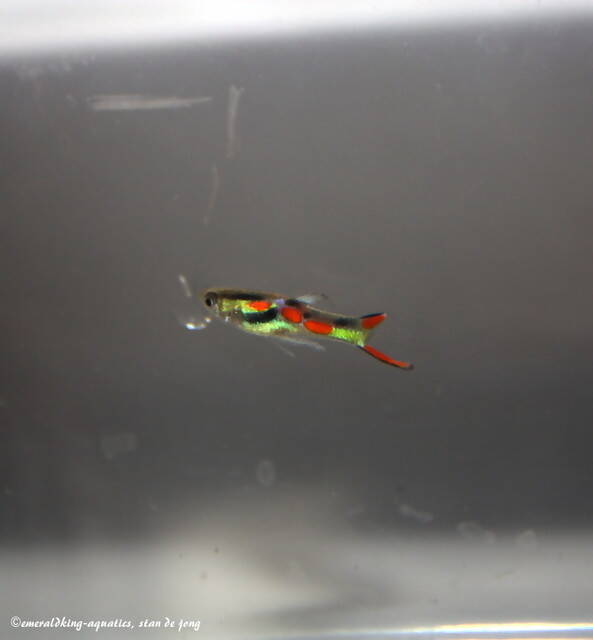

Above: The development of a male black bar endler.
Typical for N-class black bars is a clear or even white dorsal. Other markings in the male's dorsal reflects most likely a hybrid black bar endler.
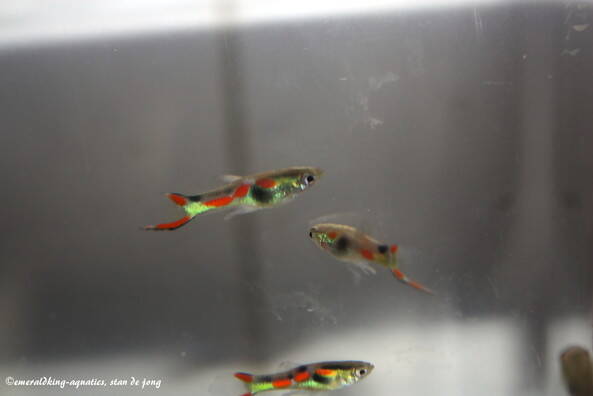
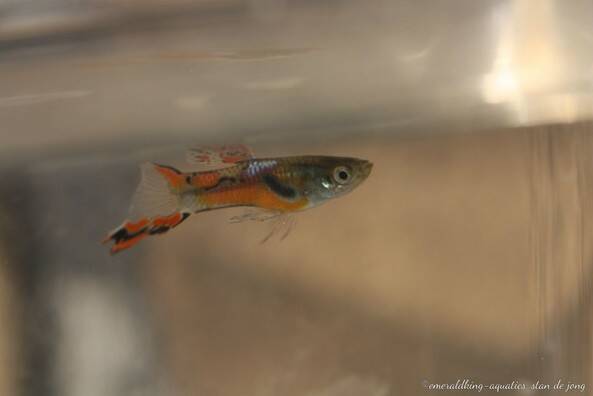
Above: An adult red black bar endler (photo left).
The black bar endler is also the first endler strain ever introduced into the aquarium scene.
Limegreen
Limegreen endlers are also known as emerald green endlers. This strain is originated from the Cumana region (coll. Adrian Hernqndez, 2006).
Typical to this strain is the limegreen stripe on the entire upper part of the male's body. There are types of males which show white dorsal fins and a vertical stripe on the side (vertical bar). They're really fertile and fast growers.
First purchase of this strain happened in 2010. I immediately fell in love with them when I first saw them.

So, when it comes to limegreen endlers, I've got two different phenotypes. One is the "greenstripe" and the other concerns the "vertical bar". On the picture below: on the left a vertical bar and on the right a greenstripe.
The commercial trade also calls them emeraldgreen endler. But the official name is limegreen endler.



Above: A bunch of juvenile limegreens males.
Tuxedo/ Black flame
I was able to get my hands on a group of tuxedo endlers as shown below in 2008. It was a pity at that time that they only had males to offer. Nevertheless, I bought them all and mixed them with some of my female black bar saddleback endlers. The F1 fry was partially tuxedo and with the F2 it resulted in only tuxedo phenotypes.
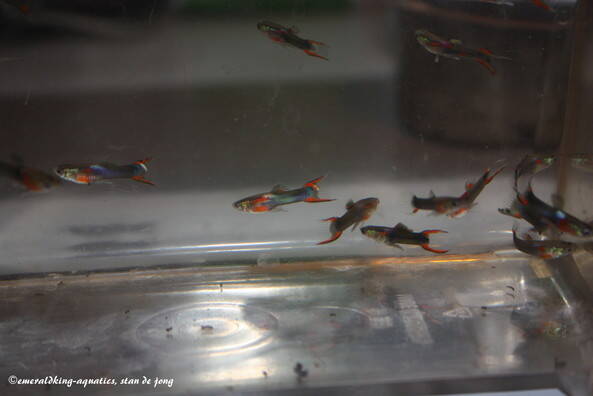
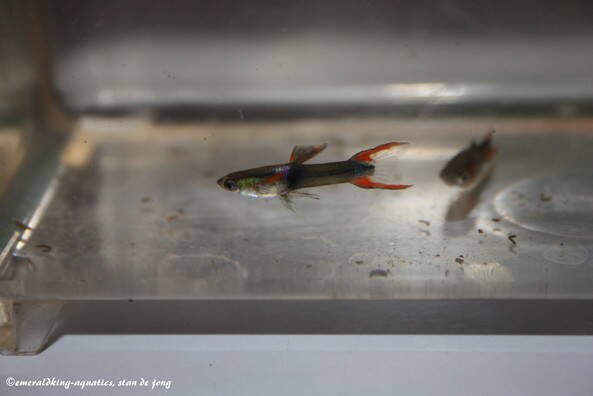
But I have used some tuxedo female endlers to create the more rigid red chest hybrids. And some do have a more darker body which comes from the tuxedo line.
In fall 2011, I was able to become the owner of a large group of tuxedo endlers → both genders (Thailand import). And as far as I'm aware of, I was the only keeper and breeder of this strain within the Netherlands at that time.
Overhere, we see an adult couple of tuxedo endlers. A typical feature of a tuxedo female is that they tend to look darker than the average female endler. Sometimes also the fins appear darker.

Throughout the years, some mutations have occured which resulted in tuxedos with silver and bronze chests instead of a red chest. And even white swords instead of red swords.
It's obvious that moscow guppy influence is one of the features in the DNA of this strain. However, if one would like to breed the black into another strain, the tuxedo female should be used for it's the female which has the dominant black gene. If one is using a male instead, the black will show up in tiny bits or even disappear with the male offspring.
Nowadays, this strain is also called black flame and half black (HB) endler.
Snakeskin (Cobra)
Below we have some snakeskin endlers (also known as cobra endlers). First colony kept by me was back in 2004.
The snakeskin pattern is really dominant and therefore absolutely competent to use for intercrossing to get snakeskin pattern realized on certain body parts of the male offspring. Not all male hybrid offspring will get this pattern but the majority will.
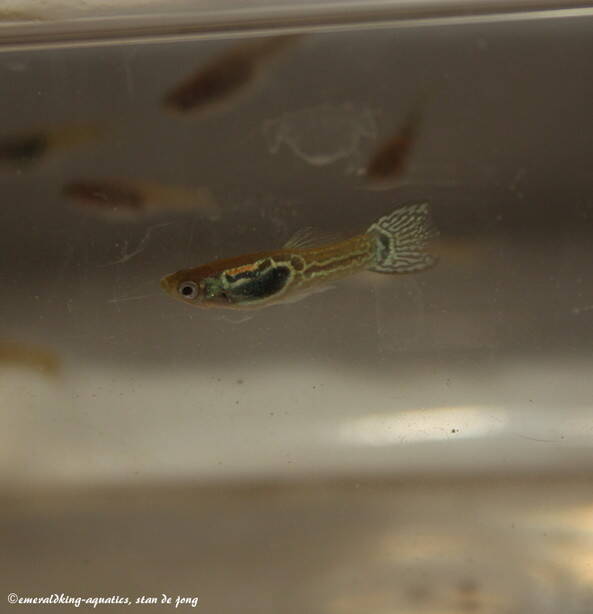
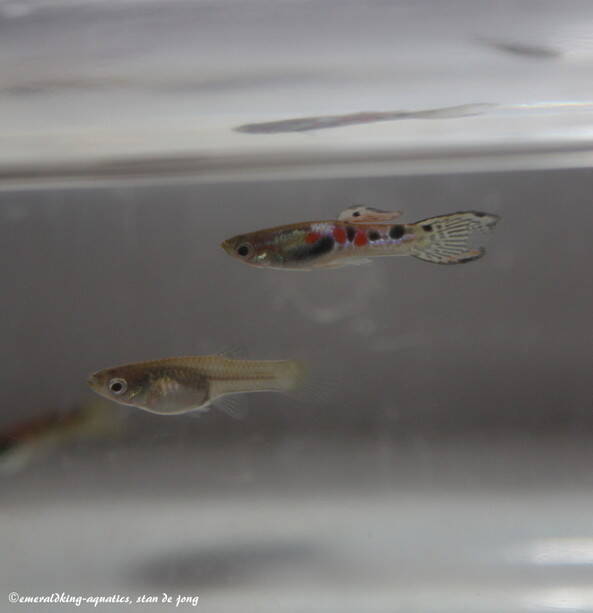
It's one of the hardiest endler strains there is. And for sure very prolific. But you need a good culling on a continuous bases for the males tend to get more slender generation after generation. So, for a ferm male body shape, try to select just the fermer build males to breed with.

Pattern on each individual male may differ. The male shown above has got hardly pattern on his body (which is less common, btw).The strain itself was a result by crossing a cobra guppy x black bar endler.
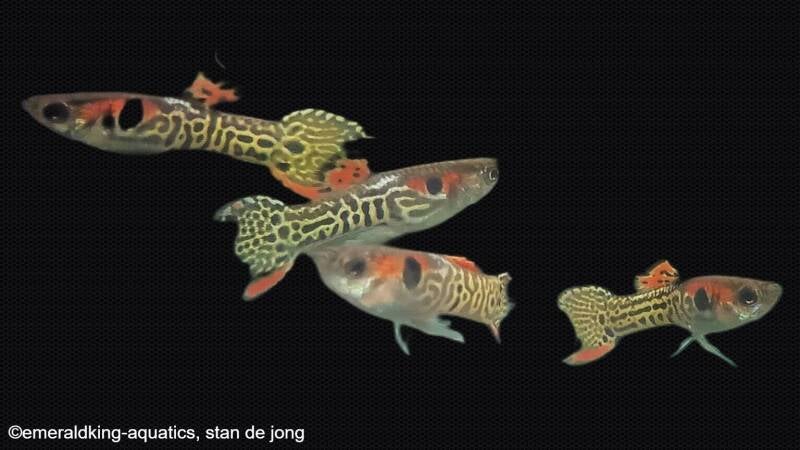
Above: This is a cobra endler hybrid strain that has got Cumana red chest endler influence instead of black bar endler influence.
Tiger hybrid
Below are shown some tiger hybrid endlers. In comparison to the average male endler... this version has a longer body length. Don't mistake this breed with the snakeskin. Its pattern is also totally different from the snakeskin. Even the black spot on its side is more focused on its shoulder up to its head. The stripes on its side are typical vertical and a certain amount of white appears in its dorsal fin and tail next to the black edges. A real beauty within the endler genus. Also phenotypes with a black head occur.

Tiger hybrids are the result by crossing galaxy medusa guppy x endler. When you look at all tiger hybrids, you'll just recognize them as being tiger endler but the patterns on each male can differ a lot. Same goes for the tail shape.

First colony of tiger hybrids kept by me goes back to 2006. Purchased them from someone who decided to keep fancy guppies instead.
In general this strain can be considered being very prolific and definitely fast growers.
Blond (flare) endler
Below some male flare (blond) endlers are shown. I started with a group of these guys in 2006 and just a small offspring seemed to have the blond look. The majority of the offspring were just like the regular black bars. Which gave me the impression that the blond gene seemed recessive. But anyways, the next generation followed and the blond look appeared again in a larger number as before. Even the normal black bars (F1) from that particular strain gave birth to blond endlers (F2) again.

The common blonde endler is a result of a cross between black bare endler x blonde guppy. The first ones purchased was in 2007. Overhere in Holland it was still a rare hybrid strain back then. Ever since 2012-2013, the commercial trade in Holland called them "venus endlers" while originally they were just called blonde endlers.

Even with these blondes, the markings or patterns can vary a lot. Most likely green, red and orange markings are occurring on the males body. When it comes to the dorsal, it can be clear or even bright colored.

Lutino endler
A variety of the blonde endler is the lutino endler. It's also a blonde based endler but with pigment disorder which relates to the eyes in this case and not the body color.
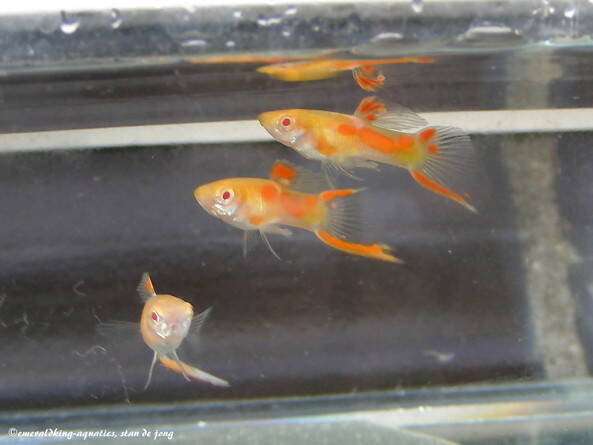
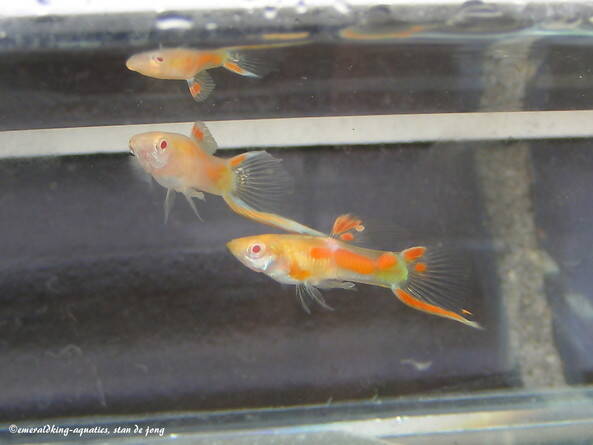
The red eyes do add a bit more to the fish in my opinion. But that's just a personal preference of course...
Lutinos just like albinos tend to be a bit more sensitive in comparison to non-inos. The first lutinos I've kept were a gift from Tobi Berensee from Berlin back in 2013.
Red scarlet (aka chili endler)
The red scarlet also known as chili endler (specifically in the States) is a remarkable colored hybrid strain. The red on its body ensures a good contrast in a well planted tank.
They were my second kind of strain of endlers to be kept back in 2005.
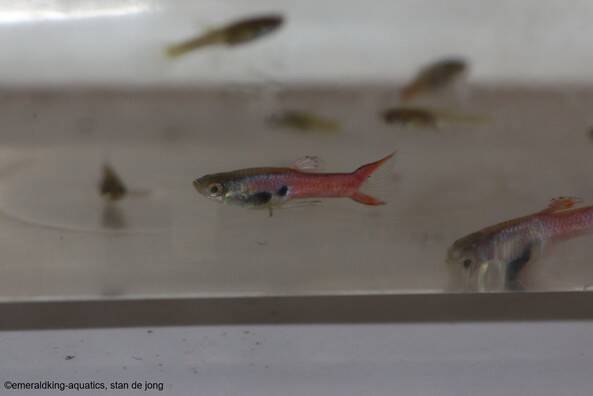
The males that I am keeping differ from coloration. I've got magenta, orange-red and deep red colored ones. What I've noticed is that about 30-40% of the born males of this breed will have the magenta look. Also this red gene seems dominant. Once you will even crossbreed with a different kind, a certain amount of red will actually appear on the male offspring's bodies. I even have some females which show a bit of red on their bellies and dorsal areas. This pic shows a more orange look but in real it has got a deep red body. In some way, the lightning wasn't too well taken.

Be aware that in the commercial trade there are red scarlet (chili endlers) sold as being pink endlers and koi endlers. These are one and the same as red scarlet endlers. What has happened? Besides red, red scarlets also carry a magenta and a Störzbach gene. Both genes are dominant. Once it's in there, it's hard to get rid of it. The combination magenta and Störtzbach (both gens come from the guppy influence) makes the endler look pink. And if you won't cull them from the colony, the body color becomes more and more pale (it's even possible that it may look like white at the end). if you will let them get away with that, most part of the male's body will become very light metallic pink and the top of the body (literally a red stripe from the saddle till the nose) and the nose remain somewhat red. For the red color cells (erythrophores) on those parts are more dense.
So, don't let you be fooled by those who claim that those are different strains than the red scarlet endler. They're one and the same strain. An example of how a pink version looks like is shown in the picture below (left male). The second picture shows a red scarlet endler which is sold as a koi endler. And I can assure you that that''s just a red scarlet endler itself.

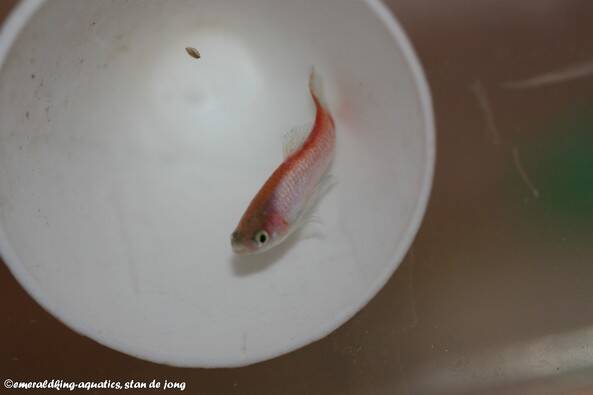
Red chest
Ever since mid 2014, I'm keeping the N-class red chests. Originally, back in 2005... I've also kept N-class red chests. But I could only buy the males at that time. So, to ensure offspring; I've used female black bar endlers. After the F2, more red chests were born and at the end I had a strain with red chests phenotypes similar to the original one. Further description of the hybrid strain is written a bit further beneath.

The typical red chest of a male can differ per individual male. It differs from orange-red, deep red till purple red. Another characteristic is the monocle on both sides of the chest unlike the black bar which a lot of other wild endlers have. On their sides will occur a metallic green and some black and red markings. They also come as double red striped on the chest and snakeskin pattern on the belly area.
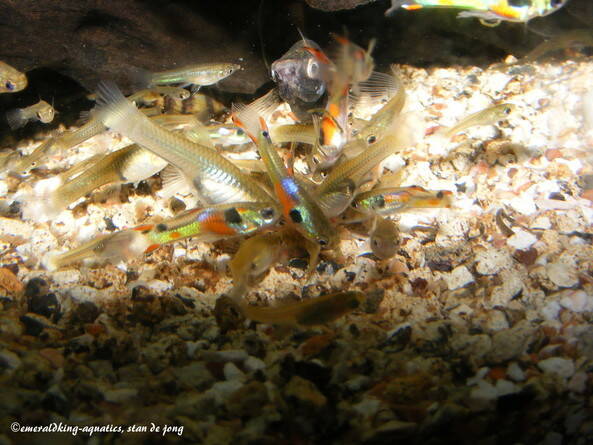
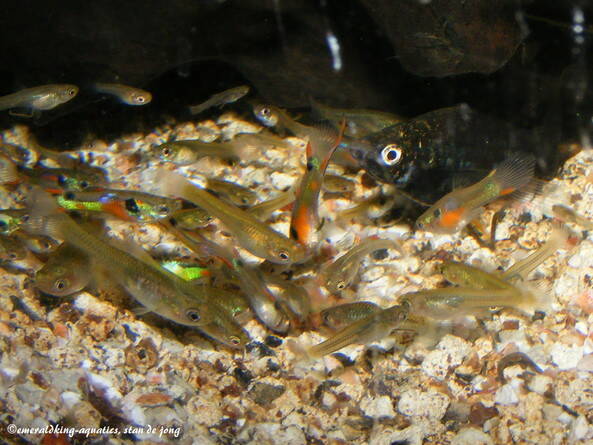
As already mentioned, ever since 2014 I'm keeping and breeding the N-class strain and got rid of my hybrid red chest strain. The red chest originates from the Cumana region, Laguna La Malaguena and in the Hyacinth stream (coll. Armando Pou / Adrian Hernandez, 1997)

If you'll breed red chest endlers, you'll notice that at some point two other phenotypes will occur. One is the so-called red chest snake (snake chest) and the so-called double stripe. With the last one mentioned, the red on the chest comes in two parts like picture 2 shows.


Red chest blonde
In 2014 I've purchased a group of blond red chest hybrids from Peter and Astrid Raschke. It's a beautiful strain and has the same markings as he grey based N-class version. The only problem I've met up with is that the red chest will fade after some generations. so, adding a grey based male to the colony will enhance the red chest marking of the new male offspring.

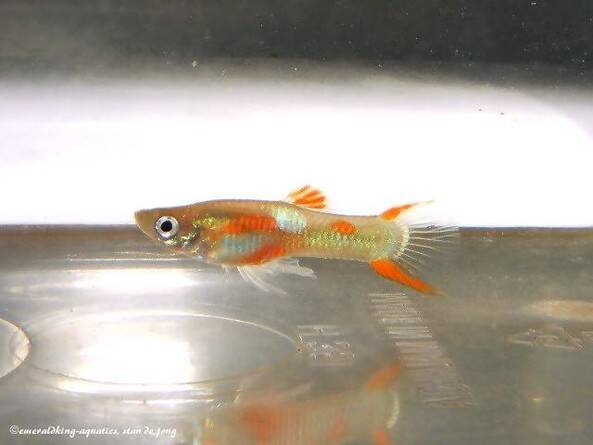
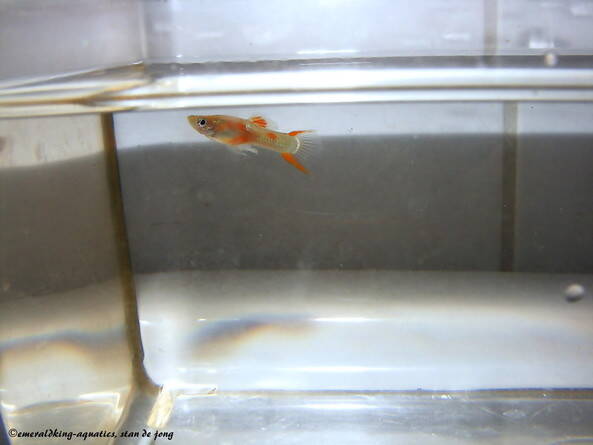
Flame tail
The flame tail endler originates from the Cumana region, Laguna La Malaguena and Laguna de Los Patos, South Lake (coll. Armano Pou / Adrian Hernandez, 1997).
The flame tail is a very slender shaped endler but enormously colorful. Also the markings on each individual male may differ. Just like the yellow top sword endler, it's got a top sword but the name suggests that there's a marking in its tail... a so-called flame shaped spot. They're also extremely easy breeders.


The flametail comes also in diverse patterns but in general it does resemble a lot to the yellow top sword endler.
Yellow top sword
The yellow top sword (YTS) originates from the Cumana region, south of Laguna la Malaguena and the Black Endler Pond (coll. Armando Pou / Adrian Hernandez, 2004).
I myself am keeping these fish ever since 2007 and added another colony back in 2008 from a fellow breeder who had an overstock of these endlers.

With its typical yellow top sword very easy to justify it's name. Just like the flame tail, this is also a slender type of endler. From time to time a larger shaped male will develop but that's just the exception... Very typical for the yellow top sword is also the vertical bar to its side.


The pattern on each individual male can be diverse. Further on this strain can be considered hardy among the variety of endlers. And for sure highly prolific..
Neon hybrid speartail
Another hybrid developed by Adrian Hernandez is the so-called neon hybrid speartail. This is a specimen which has a typical speartail when it comes to the males. It's an easy breeder as well.

On the pictures below we see the colors and patterns of these males much better. These are pictures with a couple of pregnant females. I've started keeping them back in 2012.

Hamburger
One of the more beautiful patterned endlers I had was the hamburger endler. It resembles somewhat to the Staeck endler. "Hamburger" had to do with the so-called "H" on the males its both sides. Karen Koomans, one of the former top breeders of Holland created this endler strain. It's a pity that Karen had to stop her activities for she was really good at her job! Illness made her decide to become inactive within this field. She deserves a lot of respect for her qualities.


I didn't get my hamburgers from her. I got them from a young boy living in my region back in 2008. His hobby had outgrown and his parents told him to get rid of the majority of the fish. It turned out that some were hamburger endlers which he didn't know of. I've bought them from him but they didn't last too long at my place. It's quite a shame for it was a very colorful and interesting endler version.
However, I've heard that some other keepers who had these fish as well told me that the strain itself wasn't that hardy.
Staeck
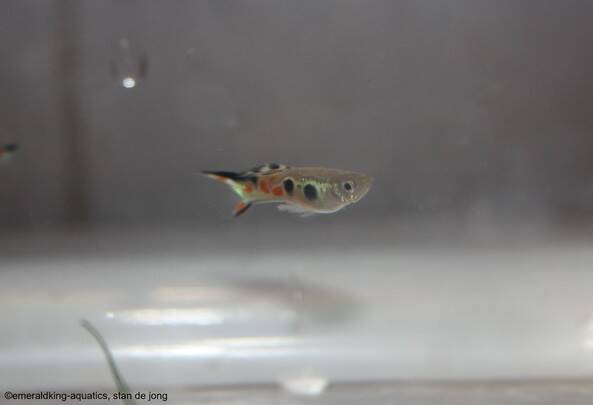
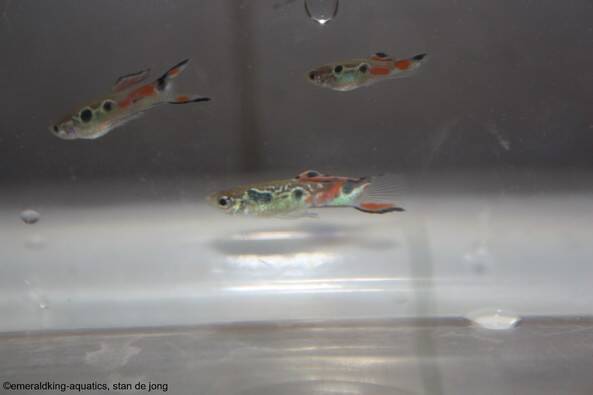
The picture above shows a Staeck endler (also known as black endler). They do resemble in a way to Hamburger endlers. The typical "H"-shape to the sides which are so specific to Hamburgers ain't present at Staeck endler males. There's also another form of Staeck endlers which have more rectangular areas on their sides.
And of course, also with this strain there are some patterns differences among the males itself. Both pictures below show this clearly. On both sides of the body there are these typical black monocles. The number of these monocles on both sides can be 1, 2, 3 or even 4.
This strain was found in Kanal de Laguna de Los Platos (Cumana region). And brought to the german Dr. Wolfgang Staeck, resident in Berlin back in 2004 which this strain was named after.
In general, Staeck endlers are as hardy as any other endler. They're quite attractive fish when it comes to their pattern. The group that I have came from Ronald Bosma (a former acquaintance of mine) who shares the same passion when it comes to wild guppies in general. In 2012 he brought them over from Altenesch (close to Bremen), Germany. I started off with a group of nine → Four males and five females. Fortunately, in the meantime it's been enlarged by young fry...


All the Staecks shown above are linebred from N-class Staecks. When I was in Berlin in 2013 I was able to see a large group of Staecks which were still having the phenotypes of how they are found in wild nature. The pictures below will show you the several phenotypes which look somewhat different from the linebred ones.

In 2013 I was able to bring back home a colony of wild phenotypes of these Staecks. It was donated to me by Stefan Hetz (picture below). These fish came from the Berliner Universität (University of Berlin). In 2016 I've decided to cross the original phenotypes with the linebred phenotypes in order to give the phenotypical diversity of the wild strain back to the strain.

Below: A male specimen with a wild phenotype (picture 1) . It's got long swords and the monocles aren't that round as with the linebred version. Neither does the wild phenotype have monocles that are surrounded by a white circle. Which is clear to see with a linebred male as shown in the second picture.

Above: Linebred male (bottom) and a wild phenotype (top).

Above: Two adult red steack endlers. The red coloration could come from the wild line which has got also more red on the body.
Ever since 2013 a rumor (one may also call it a speculation) has been going on wether the Staeck endler is indeed a Poecilia wingei or a Poecilia reticulata. A DNA test could give the ultimate answer on that question. In some way, it has got the resemblance of a wildguppy in comparison to an endler. But the courting resembles the courtship of an endler. Maybe it's a natural hybrid between Poecilia wingei and Poecilia reticulata. Who knows for sure...? Either way, it remains a stunning livebearer. I did put the question out there to Dr.Wolfgang Staeck himself while I was in Berlin. According to him it's a genuine Poecilia wingei.
Below: Dr. Wolfgang Staeck and me.

Blue star
The blue star endler is originated from the Campoma region, bridge in Campoma Village (coll. Philippe Voisin / F.Nicole).
Synonyms for this strain are blue voisin and blue français.
It's a real beauty and despite of the bluish appearance, it's quite different from the japan blue. These guys found their way to my place after a three and a half hours car drive from my friend from Germany back in 2012.

Look at the metallic blue shining on his body. The blue differs from the top to the lower part of the body. Further on the males have orange or red spots and a bottom sword (or lower sword) which can be orange or white with and a black seam.
Up till 2012 it was one of the more pricey endlers on the market... € 50,00 a pair was normal at that time.

Like any other endler, also the blue star is mutation sensitive. The commercial trade likes to make advantage of that. If you keep them in mass reproduction, mutations will occur faster (happens by other endler and guppy strains as well). One of the mutations of the blue star is that they can develop a top sword next to the lower sword. If you won't cull these, the top sword will become more pronounced. At some point, you're creating a double sword blue star. The commercial trade however likes to sell such double sword blue stars as a different strain. So, don't let yourself be fooled by that and just be aware of it that it's just a mutated blue star endler. Nothing more...!
Below: A normal lower sword male.

Above: A doublesword male (mutation).
Blonde blue star

Besides this N-class blue star as described above, I also breed a blond version of the blue star. In this case it concerns a K-class blue star. It's a hybrid between blue star x flare (blonde) endler. I've got my first breeding group of this hybrid through Peter Raschke in 2014. He's a German breeder and created this specific hybrid strain. I just fell in love with these hybrids when I saw them for the first time at the International Endler Championship in Berlin in 2013.

They do tend to be a bit larger in body shape in comparison to the N-class blue star. Some males have some color in their dorsals which you won't see with N-class blue star.
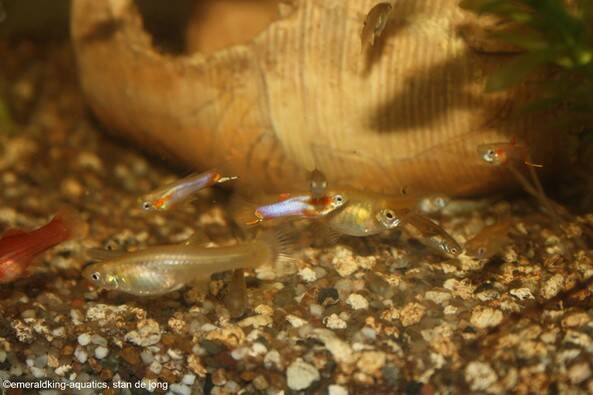
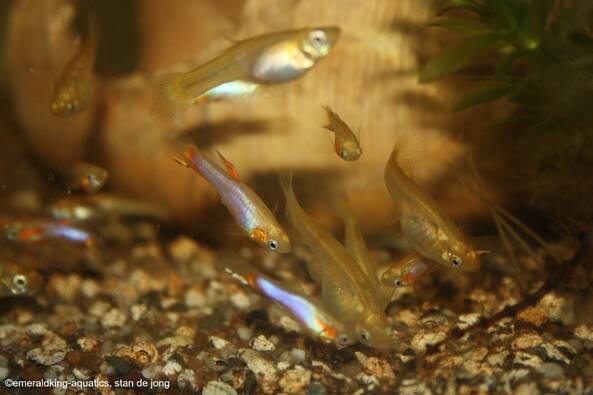
After a year of keeping them, the blue faded after some generations. I've added an N-class male blue star to the colony and some extra females of the flare red scarlets. The next blonde male offspring which turned out more red but had the right markings of a blue star and all the grey based offspring from these batches were culled. They were put in a mutt tank. All others were kept in the tank with all the blonde blue stars. All male blondes with the right blonde base and right markings were crossed to their sisters. Their offspring were all blonde and all males were marked intense blue again.
In general, the blonde version has the same characteristics as the grey based N-class blue star. If you'd like to have a nice variation of the blue star, this is the one...

Orchid
The Orchid endler is originated from the Cumana area (coll. Adrian Hernandez, 2006).
Besides known as "Orchid endler", this strain is also known as "Black hat endler". "Black hat" because of the black marking on te male's head.
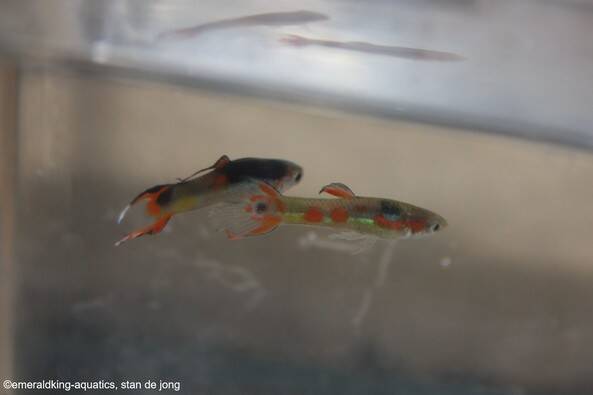
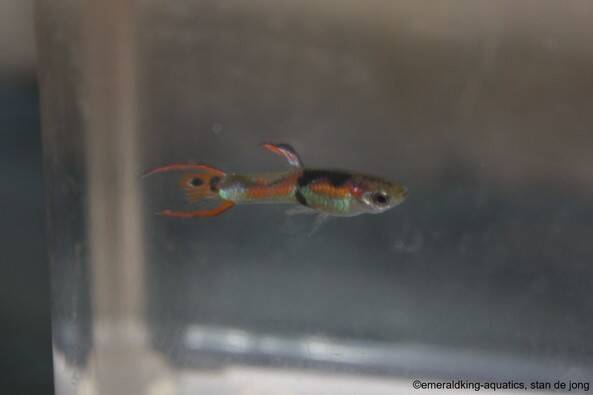
My group of orchids endlers are swimming at my place ever since summer 2013. I've purchased a large group of Jan van Rooij (member of Zilverhaai Beringen, Belgium) when I was in Antwerp. Sadly, Jan van Rooij has died in 2016. A remarkable man with a lot of passion for guppies and endlers.
It's also amazing how many phenotypes there are within the orchid strain. But I was so pleased that I was able to get my hands on a large group at once.
In August 2015 I had a donation of a large group of orchids by Henk Buddingh with more black traits.
Other phenotypes of these males have green and a bit blue in their bodies. Some have small white, red and even black swords. Others have a peacock in their tail.
Below: This picture shows the typical black hat on a male orchid endler.

El Tigre
The El Tigre endler is originated from the Campoma region, El Tigre stream, road between Cariaco and Casanay (coll. Philippe Voisin, 2011).
I was amazed in spring 2013 when I saw a picture of the El Tigre endler which Phillipe Voisin posted on the internet. Good friend of mine René Kruter asked me at a certain moment if I would like to join him to pay a visit to Phillipe Voisin to purchase certain strains of endlers. One of them would've been the El Tigre endler. But in some way we never came to that point to make that trip.
When I was acknowledged who my fellow jurors at the International Endler Championship 2013 in Berlin were, I was able to order some of a fellow juror by the name of Knut Bieler. He gave a group of juvenile endlers which had their first offspring at Christmas 2013. In the third weekend of January 2014 the Hannover pet fair was held. My acquaintances from Berlin (Claus Osche and Katja Hirsch {Tyka}) were going to Hannover with my order of fish. One of the strains was the El Tigre again. To enlarge my group of these fish. Another good friend of mine brought these fish to me for I was occupied with family matters and so I wasn't able to go to Hannover myself that weekend.
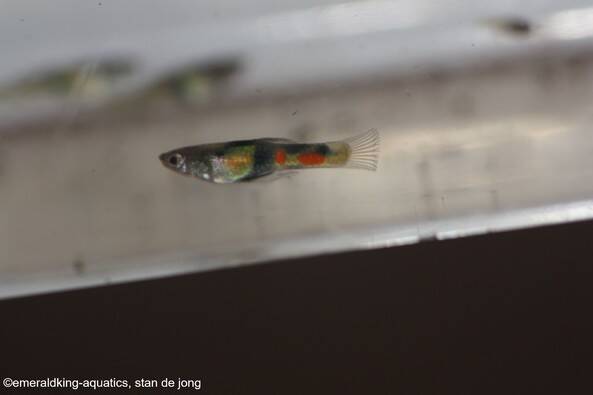

For now, I do have two separate colonies of these fish swimming around. They don't tend to become that large. Not that most endlers become so large but this strain remains a bit smaller (both male and female). When it comes to giving birth to offspring, the number of the newborns are low in comparison to other endlers.
Below we've got some pics of adult and juvenile males of the El Tigre.


The ensure as much black markings on the new male offspring, one should use the females with the black or partially black dorsals. Just like the female shown in the picture above.
El Silverado
The El Silverado endler originated from Cumana City (coll. Philippe Voisin, 2013).
The first couples were given to me in 2014. It took a while before they reproduced themselves. But at the end they did well.
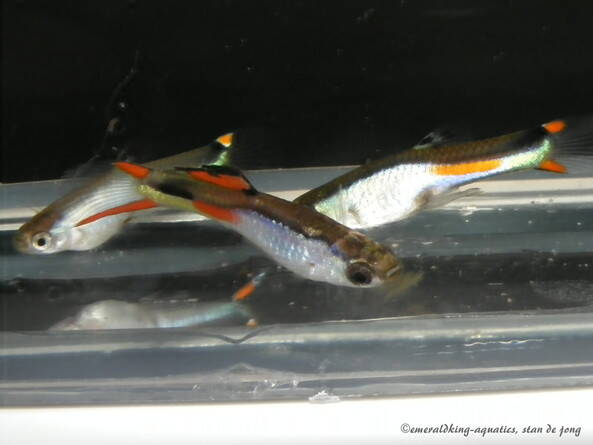
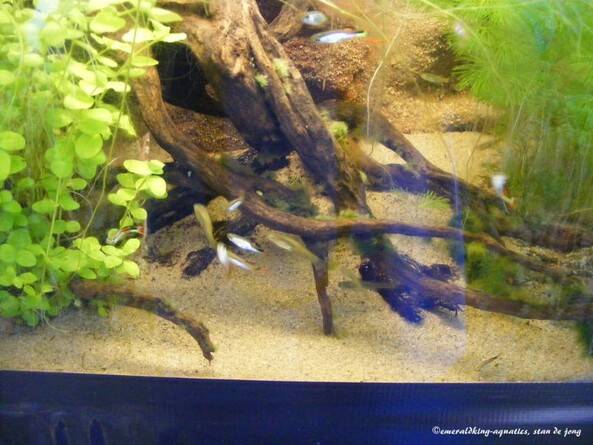
It's a beautiful silver chested endler with green, red and black markings on its body. The length of those red swords do differ per individual male. In some way, if I have to compare this strain with other endler strains (N- or even K-class) , this strain has something classy about itself...

Light blue top sword
The light blue top sword originated from the Cumana area, south of Laguna la Malaguena and the Black Endler Pond (coll. Armando Pou / Adrian Hernandez, Cumana Lagunas collections (97-2004)


It's an endler with a magical metallic shine with orange, red, green and black markings. The top sword can be straight or even curved shaped. This varies per individual male. Both male and female tend to get bigger in size than the average endler.
The first couples I owned came from an import from Osaka, Japan in 2014. A bit more expensive but they were of a high quality level and worth the money. They seemed very prolific and fast growers.
Rainbow
The rainbow endler originates from the Cumana region (coll. Philippe Voisin, 2013).
Back in 2014 at the international livebearer championship in Diemelsee-Adorf (Germany), my friend Gasper Gomboc from Slovenia brought me a couple of bags with rare livebearers. One of them was a group of juvenile rainbow endlers. Some extra breathing bags with similar endlers were given to me as well to be send to two other Dutch breeders once I would be back home again.

This strain concerns a slender bodytype. Looking at the pattern, it shows a bronze body color with red, orange and black markings. Some filigree pattern is showing in the caudal fin and the dorsal shows a black edge.

Campoma nr.3
The Campoma nr.3 originates from the Campoma region (coll. Philippe Voisin, 2008).
First colony of this strain had been purchased by me in 2014 at an auction. What seemed remarkable of this strain was the ferm black top sword of the males besides that also the body was a lot more ferm than most endler strains.

Furthermore, it has got a strong metallic shine and a colour pattern of orange, green, some bluish and black markings. How the pattern is situated on each male does vary. To me this is an endler which has a certain number of masculinity...

Also this strain should be considered being very hardy. These specimens shown overhere came from an outdoor tank of mine.
Campoma nr.7
The Campoma nr.7 endler is originated from the Campoma region (coll. Philippe Voisin, 2008).
Also this strain has been given to me by Gasper Gomboc when I was at the international livebearer championship in Diemelsee-Adorf back in 2014.

Also this strain shows a slender male bodytype. It shows blue, red, and black markings on its body. The caudal fin shows a yellow top part with a peacock in it and a slight curved red-orange bottom sword. Furthermore, it does show snake chest pattern. The intensity of the snake chest pattern does differ per individual male. And a small number of males have a plain colored chest.

It's a bright coloured endler and for sure worthwhile to keep...
Campoma nr.9
The Campoma nr.9 endler is originated from the Campoma region (coll. Philippe Voisin, 2008). They found their way to my place in 2015 at an auction.
It concerns a very bright colored specimen with orange, red, green, blue, yellow en black markings. The yellow dorsal is very remarkable. Although, to me it seems more similar to a Poecilia reticulata instead of a Poecilia wingei when you look at the body shape, it seems to be a true Poecilia wingei...

Among the males the caudal fin can differ. Most have slight double swords till none and some have an extended top sword or bottom sword..

Black markings on te male's body do occur as monocles as well...

Campoma nr.21
The Campoma nr.21 originates from the Campoma region (coll. Philippe Voisin, 2008). I've obtained them from an acquaintance in 2017.
There's not that much data on this strain to be found.
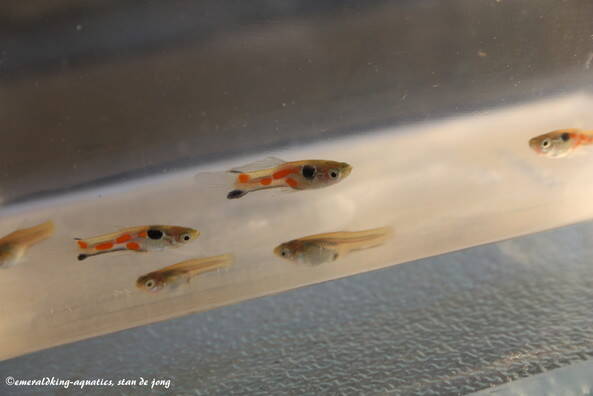
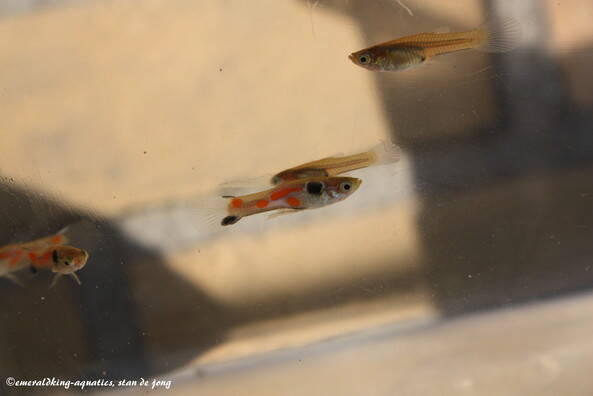
Remarkable is the monocle on each side of the shoulder on each male and the very short sword pattern in the caudal fin.
Campoma nr.42

The Campoma nr.42 originates from the Campoma region (coll. Philippe Voisin, 2010). Commercially wise this endler is also known as "Gypsy endler". I've obtained this strain from a Belgian breeder back in 2017. Also about this endler there's not that much data available.

Campoma nr.46 snake
This endler originates from the Campoma region. I don't know the exact data with the exception of the year of collection 2012 by Philippe Voisin. I've searched for more info but couldn't find any. Nevertheless, it's a brilliant looking wild strain.
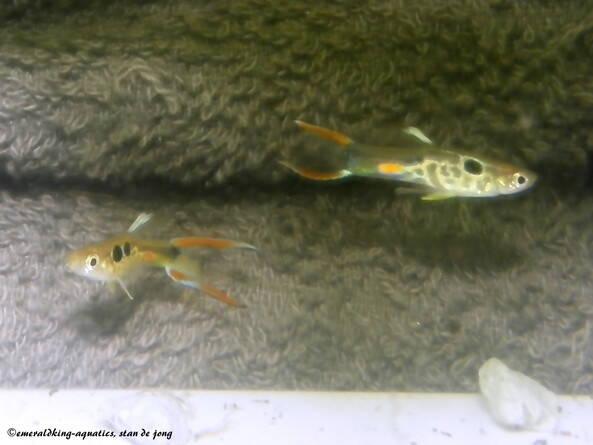
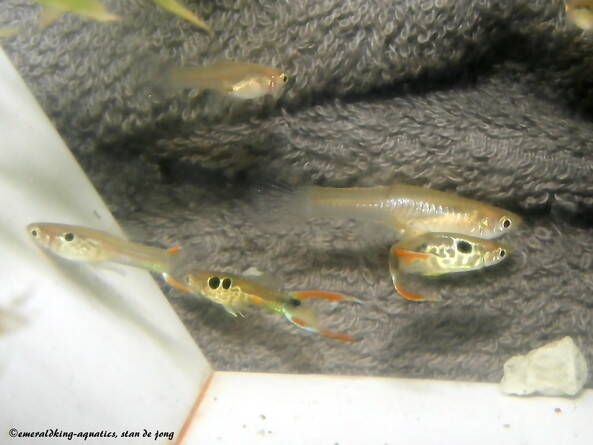
This strain swims in one of my tanks ever since late 2016 and was brought to me by a German breeder who paid a visit to my place. He has been looking for El Tigre endlers at my place which he had a problem with finding in his area. And the gift of some juvenile Campoma nr.46 snakes was quite a surprise to me.
Remarkable is the snake pattern on the male's chest and one or two black dots on the male's shoulder. Both swords in the male's tail are red or orange colored.
Rio Oro (2006)
The Rio Oro endler is originated from the Campoma region, entree Aquas des Moises (coll. Paul Eckstein, 2006).
This slender shaped strain is a small kind of endler (males) with black, orange or red and green markings. Further on it has a top sword which is black edged and a slight bottom sword which is also black edged. Also the dorsal is dark edged.

The first specimens of this strain was given to me by Axel Eywill back in 2014. They were juveniles and a few eeks later I've added another small group to grow the colony about a week after I've got the first ones. That second group was purchased by me at an auction in Sauerland, Germany.
Quite easy to keep and for such a small endler quite hardy.


There's also another phenotype of the Rio Oro which is known from D.Gentzsch. This variety shows a really different pattern on its body. The black markings are less present and in some way, I do prefer this look more than the one described above.

There aren't even swords present with this phenotype. Red or orange and green markings are still there. Typical is that this phenotype has got a clear dorsal. So, no markings at all...

I've purchased this phenotype also from the same auction (Sauerland, Germany) back in 2014.
Santa Maria bleeding heart
The Santa Maria bleeding heart endler is a beautiful patterned hybrid strain which has its origin in Japan. So far known this strain has been developed by Kenichiro Tamura.
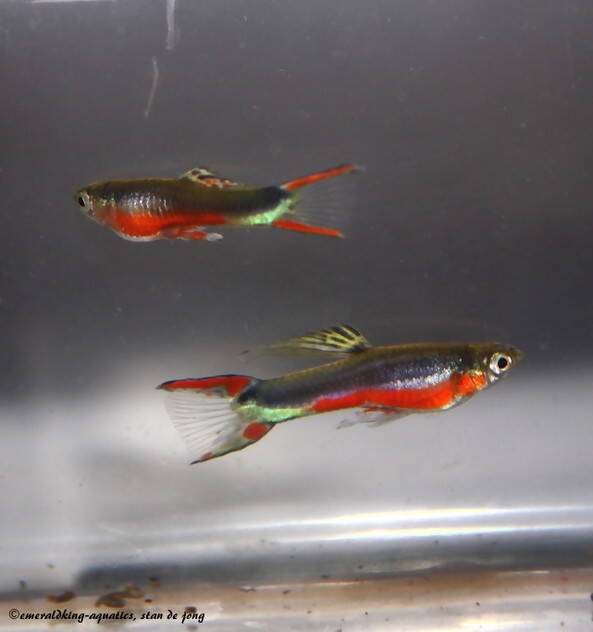
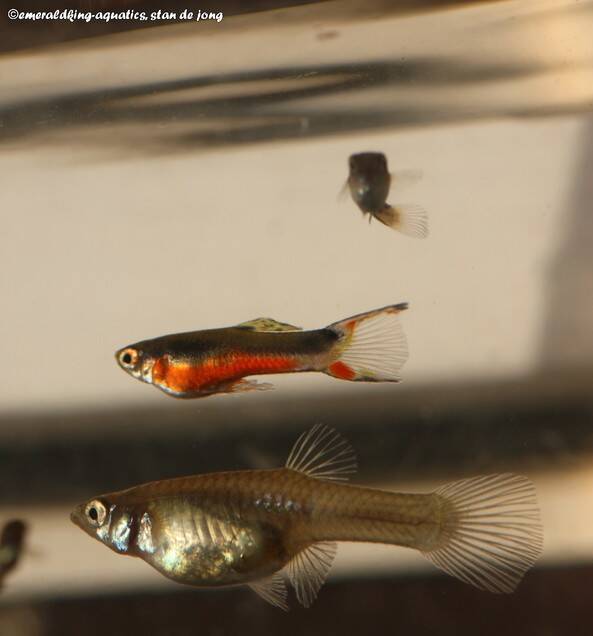
It's got a stretched body shape (more or less torpedo shaped). The upper part of the body is dark colored (almost black) and the bottom part of the body shows a deep red colour. Notice that the red part could also be a bit like orange. This differs per individual male. A small green or blue marking at the end towards the caudal fin wil be shown. And it's got a short double sword.
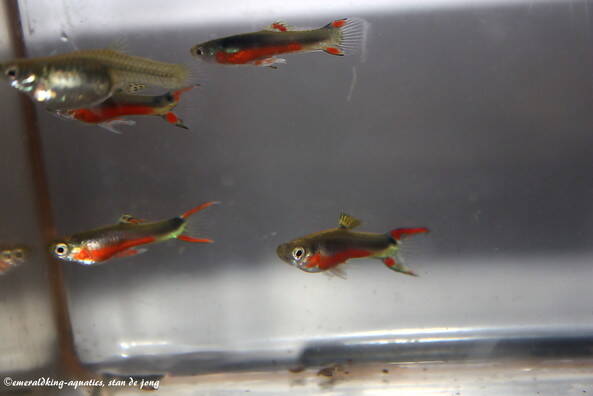
The strain I've got has been provided by Peter and Astrid Raschke in spring 2016.
Cardinal
Well, in 2017 a new hybrid strain showed up at social media and so on. Basically, most pictures of them were posted at foreign forums. In that same year, they also showed up in our country. It's a sparkling colored strain and does resemble a cardinal tetra with the metallic blue (almost azure) on the upper part of the body and the metallic red on the lower part of the body.

Furthermore, the males do have translucent fins. But the caudal does show some short sword pattern in the upper and lower fin rays.
It's not a large build endler and slender for sure when it comes to the males. In every other way, it's got a behavior like most endlers.


Yellow saddleback
This hybrid has been developed by Japanese breeder Hiroshi Sugino.
I've seen an earlier version of the saddlebacks already back in 2013 at the international endler championship in Berlin. Although, I was already interested in this hybrid; there was no one who wanted to sell them at that time.
Below: A male entry of the saddleback hybrid endlers during the international endler championship back in 2013 in Berlin (pictures taken by Stefan Hetz).

What's not really well established at this point, is that the doublesword isn't stable with every male specimen. The caudal is marked with yellow, black, red and some do have tiny swords.They come as a yellow chest and a red chest phenotype.


But it's a nice hybrid strain though, which is getting more commercial ever since the beginning of 2018 via the Dutch wholesale dealers.


